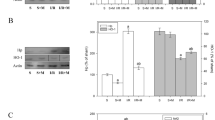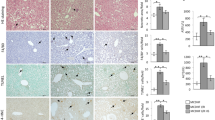Abstract
The effect of low-molecular-weight heparin (LMWH) on hepatic mitochondrial metabolism was compared with that of unfractionated heparin (UH) after the intravenous administration of these two kinds of heparin to normal rabbits. The magnitude of decrease in blood triglyceride levels 5 min after administration of UH (200 U/kg) was significantly greater than after LMWH (200 U/kg). Free fatty acid levels in the blood were significantly higher after this dose of UH than after LMWH. Blood total ketone body levels (acetoacetate+3-hydroxybutyrate) 15 min after injection of 50 U/kg of UH were significantly higher than those after a dose of 50 U/kg of LMWH, and levels after 200 U/kg of UH were significantly higher than those after 200 U/kg of LMWH at 15, 30, 45 and 60 min. Enhanced ketogenesis was not noted after LMWH at any of the doses, or after UH at 3 U/kg. Arterial ketone body ratio (AKBR; acetoacetate/3-hydroxybutyrate), which reflects the hepatic mitochondrial oxidation-reduction state (NAD+/NADH), was maintained above 1.0 in all groups except in the U-200 group, while AKBR in that group was significantly decreased to 0.99±0.14 at 30 min, and further decreased to 0.80±0.08 at 60 min. These results indicate that LMWH has less effect on lipolysis than UH and does not enhance ketogenesis, resulting in less deterioration of mitochondrial redox state.
Similar content being viewed by others
References
Wilson NV, Melissari E, Standfield NJ, Kakkar VV (1991) Intra-operative antithrombotic therapy with low molecular weight heparin in aortic surgery. How should heparin be administered? Eur J Vasc Surg 5:565–569
Deuber HJ, Schulz W (1991) Reduced lipid concentrations during four years of dialysis with low molecular weight heparin. Kidney Int 40:496–500
Persson E, Nordenström J, Nilsson-Ehle P, Hagenfeldt L (1985) Lipolytic and anticoagulant activities of a low molecular weight fragment of heparin. Eur J Clin Invest 15: 215–220
Bergqvist D, Hedner U, Sjörin E, Holmer E (1983) Anticoagulant effects of two types of low molecular weight heparin administered subcutaneously. Thromb Res 32:381–391
Bengtsson G, Olivecrona T, Höök M, Riesenfeld J, Lindahl U (1980) Interaction of lipoprotein lipase with native and modified heparin-like polysaccharides. Biochem J 189:625–633
Connor WE, Hoak JC, Warner ED (1963) Massive thrombosis produced by fatty acid infusion. J Clin Invest 42:860–866
Mahadevan V, Singh H, Lundberg W (1965) Effects of saturated and unsaturated fatty acids on blood platelet aggregation in vitro. (30702) Proc Soc Exp Biol Med 121:82–85
Salzman EW, Rosenberg RD, Smith MH, Lindon JN, Favreau L (1980) Effect of heparin and heparin fractions on platelet aggregation. J Clin Invest 65:64–73
Tansey MJB, Opie LH (1983) Relation between plasma free fatty acids and arrhythmias within the first twelve hours of acute myocardial infarction. Lancet II:419–422
Van Harken DR, Dixon CW, Heimberg M (1969) Hepatic lipid metabolism in experimental diabetes. V. The effect of concentration of oleate on metabolism of triglycerides and on ketogenesis. J Biol Chem 244:2278–2285
Siess EA, Kientsch-Engel RI, Wieland OH (1982) Role of free oxaloacetate in ketogenesis. Derivation from the direct measurement of mitochondrial [3-hydroxybutyrate]/[acetoacetate] ratio in hepatocytes. Eur J Biochem 121:493–499
Lehninger AL, Sudduth HC, Wise JB (1960) D-β-Hydroxybutyric dehydrogenase of mitochondria. J Biol Chem 235:2450–2455
Ozawa K, Aoyama H, Yasuda K, Shimahara Y, Nakatani T, Tanaka J, Yamamoto M, Kamiyama Y, Tobe T (1983) Metabolic abnormalities associated with postoperative organ failure—a redox theory. Arch Surg 118:1245–1251
Mellanby J, Williamson DH (1974) Acetoacetate. In: Bergmeyer HU (ed) Methods of enzymatic analysis. Academic Press, New York, pp, 1840–1843
Williamson DH, Mellanby J (1974) D-(−)−3-Hydroxybutyrate. In: Bergmeyer HU (ed) Methods of enzymatic analysis. Academic Press, New York, pp, 1836–1839
Heimberg M, Weinstein J, Kohout M (1969) The effects of glucagon, dibutyryl cyclic adenosine 3′, 5′-monophosphate, and concentration of free fatty acid on hepatic lipid metabolism. J Biol Chem 244:5131–5139
MacGarry JD, Foster DW (1980) Regulation of hepatic fatty acid oxidation and ketone body production. Annu Rev Biochem 49:395–420
Keller U, Gerber PPG, Stauffacher W (1988) Fatty acid-independent inhibition of hepatic ketone body production by insulin in humans. Am J Physiol 254:E694-E699
Nakatani T, Ozawa K, Asano M, Ukikusa M, Kamiyama Y, Tobe T (1981) Changes in predominant energy substrate after hepatectomy. Life Sci 28:257–264
Nakatani T, Yasuda K, Ozawa K (1988) Hyperglycemic hyperosmolar nonketotic dehydration in relation to blood ketone body ratio, in partially hepatectomized rabbits. Am J Surg 155:559–563
Nishikawa K, Nishihira T, Taki Y, Morimoto T, Yokoo N, Shimahara Y, Mori K, Yamaoka Y, Ozawa K (1988) Biological significance of enhanced ketogenesis in hepatectomized patients and aged rat liver mitochondria. Surg Res Commun 3:251–261
Author information
Authors and Affiliations
Rights and permissions
About this article
Cite this article
Sasaki, H., Yamaguchi, T., Kumada, K. et al. Advantageous effect of low-molecular-weight heparin administration on hepatic mitochondrial redox state. Res. Exp. Med. 194, 139–145 (1994). https://doi.org/10.1007/BF02576374
Received:
Accepted:
Issue Date:
DOI: https://doi.org/10.1007/BF02576374




